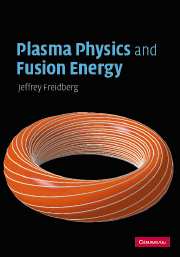Book contents
- Frontmatter
- Contents
- Preface
- Acknowledgements
- Units
- Part I Fusion power
- Part II The plasma physics of fusion energy
- 6 Overview of magnetic fusion
- 7 Definition of a fusion plasma
- 8 Single-particle motion in a plasma – guiding center theory
- 9 Single-particle motion – Coulomb collisions
- 10 A self-consistent two-fluid model
- 11 MHD – macroscopic equilibrium
- 12 MHD – macroscopic stability
- 13 Magnetic fusion concepts
- 14 Transport
- 15 Heating and current drive
- 16 The future of fusion research
- Appendix A Analytical derivation of 〈ς v〉
- Appendix B Radiation from an accelerating charge
- Appendix C Derivation of Boozer coordinates
- Appendix D Poynting's theorem
- Index
- References
13 - Magnetic fusion concepts
Published online by Cambridge University Press: 14 May 2010
- Frontmatter
- Contents
- Preface
- Acknowledgements
- Units
- Part I Fusion power
- Part II The plasma physics of fusion energy
- 6 Overview of magnetic fusion
- 7 Definition of a fusion plasma
- 8 Single-particle motion in a plasma – guiding center theory
- 9 Single-particle motion – Coulomb collisions
- 10 A self-consistent two-fluid model
- 11 MHD – macroscopic equilibrium
- 12 MHD – macroscopic stability
- 13 Magnetic fusion concepts
- 14 Transport
- 15 Heating and current drive
- 16 The future of fusion research
- Appendix A Analytical derivation of 〈ς v〉
- Appendix B Radiation from an accelerating charge
- Appendix C Derivation of Boozer coordinates
- Appendix D Poynting's theorem
- Index
- References
Summary
Introduction
The goal of Chapter 13 is to describe the various magnetic configurations currently under investigation as potential fusion reactors. As will become apparent there is a substantial number of concepts to discuss. To succeed, each of these concepts has to successfully overcome the problems not only of MHD equilibrium and stability (p), but also of transport (τE) and heating (T). Even so, it still makes sense to introduce the concepts at this point in the book, immediately following MHD. The reason is that the underlying geometric features that distinguish each concept are primarily determined by MHD behavior. In contrast, transport is a far more difficult issue and significant progress has been made only for the tokamak configuration. With respect to heating, there are several techniques available providing a reasonable number of options. Because of this flexibility, heating can be accommodated in most fusion configurations, and thus is not a dominant driver of the geometry.
To motivate the discussion recall that the main objective of MHD is to discover magnetic geometries that are capable of stably confining sufficiently high plasma pressures to be of relevance to a fusion reactor. The leader for many years in terms of overall performance has been the tokamak which will therefore serve as the reference configuration against which all other concepts must be measured.
- Type
- Chapter
- Information
- Plasma Physics and Fusion Energy , pp. 333 - 448Publisher: Cambridge University PressPrint publication year: 2007



